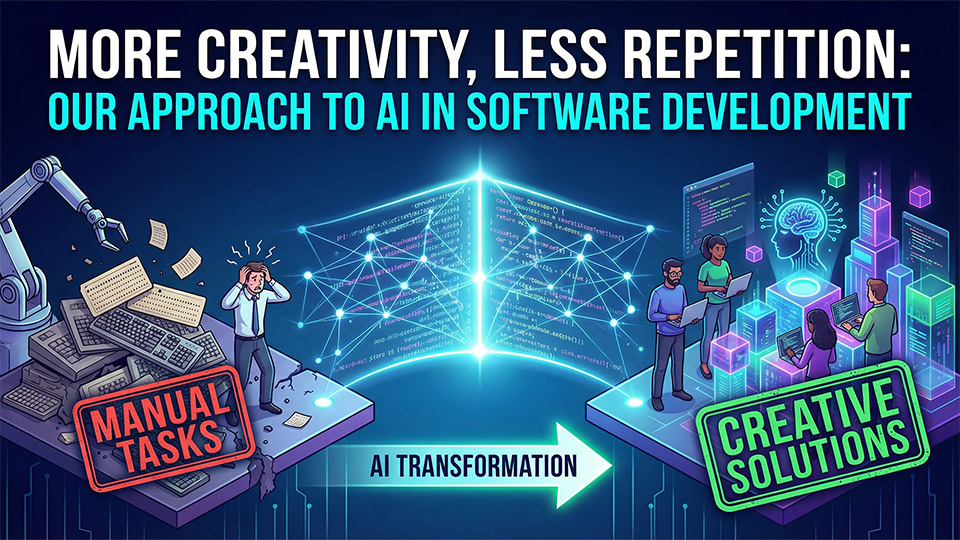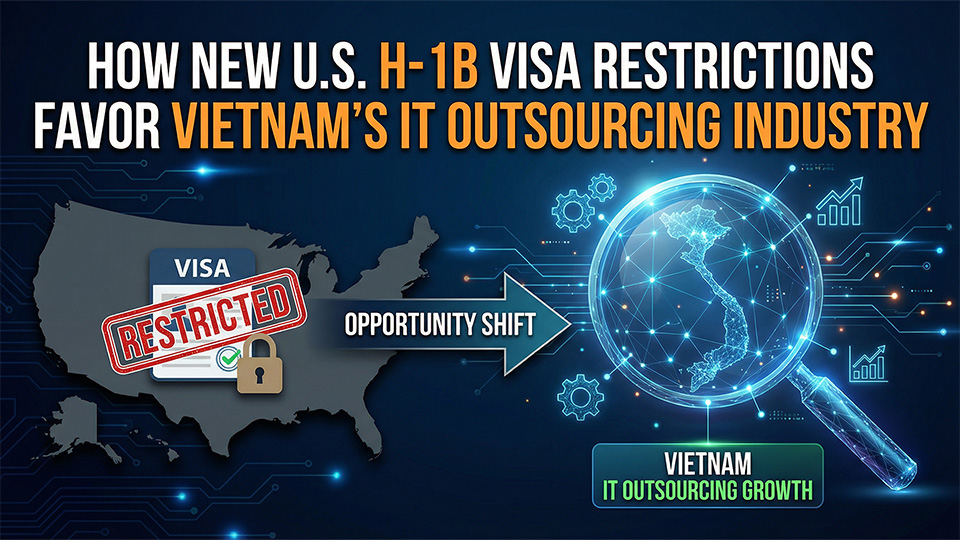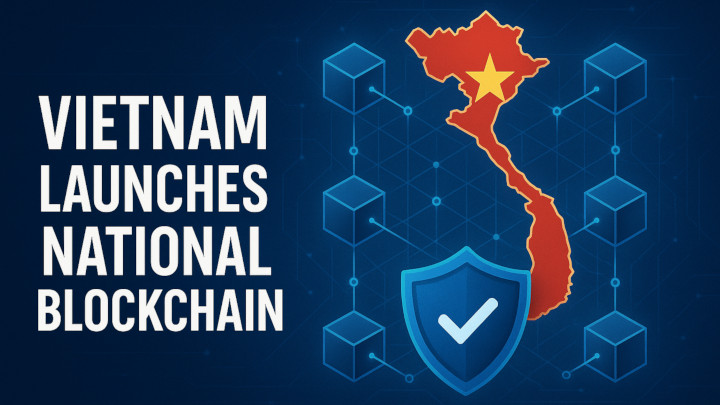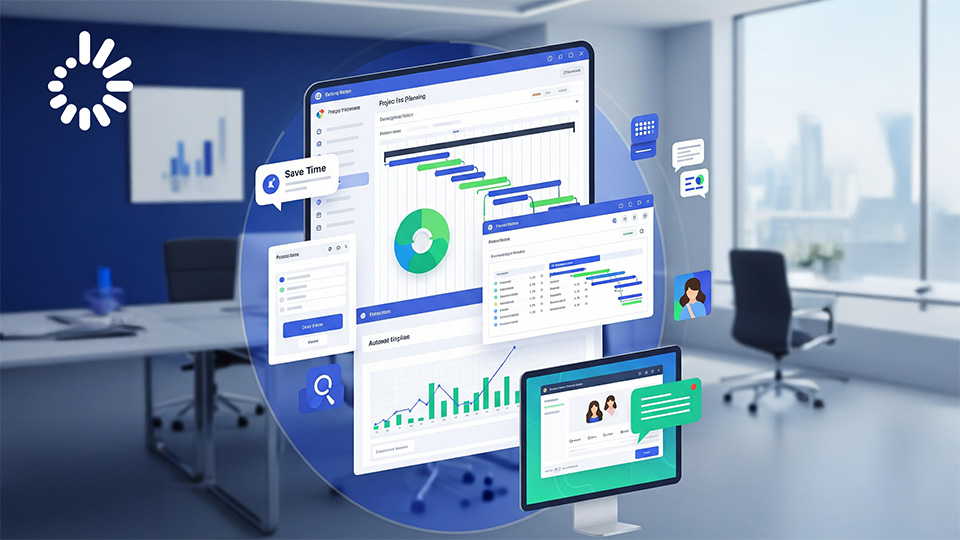April 2, 2025
What is Smart Agriculture? A Beginner’s Guide to Farming 4.0
By 2050, the global population is expected to reach nearly 10 billion people. With limited farm land, increasing climate instability, and rising food demand, can traditional farming methods keep up?
Smart Farming—powered by advanced technologies like AI, IoT, and big data—offers a transformative solution.
While the benefits of Smart Farming for productivity, sustainability, and resource efficiency are widely recognized, current implementations often overlook key challenges: smallholder farmers left behind, bias in agricultural technologies, climate resilience gap and data monopolies.
In this article, Dirox will explore how Smart Farming can become more inclusive, resilient, and farmer-centric. If you're wondering how to implement smart farm solutions, you're at right place! We will discuss:
- The core concepts of Smart Farming
- The benefits of Smart Farming
- Key technologies driving Smart Farming
- Case studies showing Smart Farming applications in real life
- A step-by-step guide to leverage Smart Farming for your business
Core Concepts of Smart Agriculture
The Pillars of Smart Farming
Smart farming is built on four key pillars that enable farmers to optimize their operations, maximize yields, and reduce environmental impact.
These pillars work together to transform raw information into actionable strategies.
1. Data Acquisition: Gathering Essential Farm Insights

Modern farms generate vast amounts of data through advanced technologies, including:
Sensors: Soil moisture sensors measure water levels to prevent over-irrigation, reducing water waste by up to 92%.
Drones & Satellites: Aerial imagery detects crop stress and pest infestations early, increasing yields by up to 20% .
Manual Data Collection: Farmers supplement automated data with field observations and traditional knowledge.
2. Data Processing: Converting Raw Data into Actionable Insights
Once collected, data must be analyzed to provide meaningful insights. Key technologies include:
AI & Machine Learning: Algorithms can predict crop diseases with up to 89% accuracy, helping farmers act before widespread damage occurs.
Cloud Computing: Platforms like John Deere’s Operations Center allow farmers to store and analyze data remotely, making precision farming more accessible.
3. Data Interpretation & Decision-Making: Empowering Farmers with Insights
Data-driven insights are useless without proper interpretation. User-friendly dashboards and expert systems translate complex data into clear recommendations:
Farm Management Software: Platforms like Climate FieldView visualize field conditions in real time.
Decision-Support Tools: AI-powered models help farmers determine the optimal time for planting, fertilization, and irrigation.
4. Automated Action: Precision Execution for Maximum Efficiency
Smart farming doesn't stop at decision-making—it also ensures seamless execution:
Autonomous Tractors: Companies like Case IH and John Deere have developed self-driving tractors. Such reduced needs for drivers can reduce labor costs by up to 25%.
Drones for Crop Spraying: Automated drones reduce pesticide use by 30-50%, minimizing environmental damage.
Robotic Harvesters: AI-powered robots pick fruits and vegetables with precision, reducing food waste.
Smart Farming vs. Precision Agriculture vs. Digital Farming
To clarify the relationship between these terms, imagine a pyramid structure:
1. Digital Farming (Foundation) – The broadest concept, integrating all data-driven agricultural technologies.
2. Smart Farming (Middle Layer) – Focuses on data access and application, optimizing farm-wide operations.
3. Precision Agriculture (Top Layer) – A subset of smart farming that emphasizes field-level precision, such as adjusting fertilizer use based on soil variation.
For example, while precision agriculture might use GPS-guided tractors to plant crops at precise distances, smart farming would integrate weather data, sensor readings, and AI to optimize the entire farm’s operations.
Digital farming, in turn, connects these elements into a holistic ecosystem, enabling seamless farm management.
By understanding these core concepts, farmers can leverage the right technologies to increase productivity, reduce costs, and create a more sustainable future for agriculture.
Benefits of Smart Farming: Beyond the Obvious
Smart farming is widely recognized for its ability to increase efficiency, reduce costs, and promote sustainability. However, beyond these well-documented advantages, smart agriculture is unlocking new opportunities that can transform the entire food system—from farm to table.
1. Enhanced Supply Chain Transparency and Traceability
Food fraud and safety concerns cost the global economy over $40 billion annually. Smart farming, powered by blockchain and IoT, can create end-to-end visibility in the food supply chain.
Blockchain for Food Traceability: IBM’s Food Trust Blockchain allows companies like Walmart to trace the origin of produce in seconds instead of days, ensuring food safety and reducing waste from recalls.
IoT for Real-Time Monitoring: Smart sensors track temperature, humidity, and location during transportation, preventing spoilage and ensuring consumers receive fresh produce.
By integrating these technologies, farmers and consumers alike can verify the authenticity and quality of food products, reducing fraud and building trust.
2. Improved Risk Management Through Predictive Analytics
Extreme weather, pests, and price volatility threaten global food security. Data analytics and AI-powered predictive models are helping farmers anticipate and mitigate these risks:
Weather Forecasting for Climate Resilience: Forecast platforms provide hyper-local weather predictions, helping farmers adjust irrigation and planting schedules.
Pest and Disease Prediction: AI models can detect crop diseases up to 10 days before visible symptoms appear, reducing losses by up to 20-25%.
Market Analytics: Platforms like Gro Intelligence analyze global commodity prices, allowing farmers to sell crops when prices are most favorable.
With real-time insights, farmers can make data-driven decisions, reducing financial losses and improving food security.
3. Empowering Smallholder Farmers with Affordable Technology
Smallholder farmers produce a third of the world’s food, yet they struggle with low yields, limited access to financing, and climate vulnerability. Smart farming is helping bridge the gap:
Low-Cost Sensors & Mobile Apps: Platforms like Azure Data Manager for Agriculture use affordable IoT sensors and AI-powered smartphone apps to provide small-scale farmers with real-time insights.
Microfinance for Agri-Tech: Organizations like Hello Tractor offer a pay-as-you-go model for renting GPS-enabled tractors, making mechanization accessible to small farmers in Africa.
Online Training Platforms: Digital tools like Precision Agriculture for Development (PAD) deliver SMS-based farming advice to over farmers in developing countries. They aim to reach 100 million farmers with their services.
By reducing barriers to technology adoption, smart farming is improving yields, incomes, and resilience for millions of smallholder farmers.

4. Promoting Regenerative Agriculture for a Healthier Planet
Agriculture is responsible for 10-12% of global greenhouse gas emissions (IPCC). Smart farming can reverse environmental damage by supporting regenerative agricultural practices:
Precision Irrigation & Fertilization: Smart irrigation systems, like Netafim’s drip irrigation, cut water use by up to 50%, preventing soil degradation.
Carbon Sequestration Tracking: AI-driven platforms enable farmers to measure and trade carbon credits, incentivizing soil restoration.
Biodiversity Enhancement: AI-powered crop rotation tools recommend diversified planting patterns, improving soil health and reducing the need for chemical fertilizers.

By restoring soil health and increasing carbon sequestration, smart farming can play a vital role in combating climate change.
5. Reducing Food Waste with Smarter Logistics
According to the UN's FAO, one-third of all food is wasted, amounting to 1.3 billion tons per year. Smart farming is tackling this issue at multiple levels:
AI-Powered Harvest Timing: Machine learning algorithms predict the optimal harvest window, preventing premature or late harvesting that leads to spoilage.
Cold Chain Optimization: IoT-powered refrigeration systems monitor temperature fluctuations in storage and transport, reducing post-harvest losses.
Retail Demand Forecasting: AI-driven inventory systems help supermarkets adjust orders based on real-time demand, preventing overstocking and food waste.
By optimizing production and distribution, smart farming helps ensure more food reaches consumers instead of landfills.
Key Technologies: A Closer Look at Emerging Trends
As agriculture continues to embrace digital transformation, several cutting-edge technologies are reshaping the industry. These innovations enhance efficiency, sustainability, and productivity, helping farmers make data-driven decisions in real time.
Edge Computing in Agriculture
Edge computing is a distributed computing framework that brings enterprise applications closer to data sources such as IoT devices or local edge servers. This enables real-time data processing directly on the farm rather than relying on cloud servers.
By analyzing data at the source—whether from soil sensors, drones, or smart irrigation systems—farmers can react faster to changes in conditions, reducing crop loss and optimizing resource usage.
For example, a farm using edge-powered irrigation systems can instantly adjust water flow based on soil moisture levels, preventing overwatering and conserving water, even in remote areas with poor internet connectivity.
AI-Powered Vision Systems
AI-powered drones and smart cameras can detect weeds with pinpoint accuracy, allowing for targeted herbicide application and reducing chemical use.
Meanwhile, automated crop inspection systems assess plant health, identify nutrient deficiencies, and predict disease outbreaks.
For instance, farmers using AI-driven cameras on autonomous tractors can identify and selectively remove weeds without harming crops, significantly reducing the need for herbicides and lowering costs.
Advanced Robotics and Automation
Agricultural robots and collaborative robots (cobots) are transforming farm labor by harvesting, sorting, and planting with precision, reducing labor costs and physical strain.
Automated tractors, robotic arms, and self-driving machinery streamline operations, ensuring consistent productivity even during labor shortages.
You can find strawberry-picking robots using AI-powered vision to identify ripe fruit, ensuring optimal harvest timing and reducing food waste.

Hyperspectral Imaging
Unlike traditional cameras, hyperspectral imaging captures a vast range of light wavelengths, providing highly detailed insights into plant health.

By analyzing the unique spectral signatures of crops, this technology can detect early signs of nutrient deficiencies, stress, or disease before they become visible to the human eye.
By using hyperspectral drone imaging, farmers can identify diseases like potassium-deficient wheat fields weeks before visible symptoms appear, allowing for precise fertilizer adjustments.
Digital Twins in Agriculture
A digital twin is a virtual replica of a physical farm, integrating real-time data from sensors, machinery, and environmental factors.
These models allow farmers to simulate different scenarios—such as adjusting irrigation schedules or testing new planting techniques—before implementing them in the field.
Digital twins help optimize resource allocation, reduce waste, and improve decision-making.
Applications: Case Studies and Innovative Examples
Across the globe, smart farming technologies are revolutionizing agriculture, improving productivity, sustainability, and resilience.
Here are some real-world applications showcasing how AI, IoT, and data-driven farming are transforming the way we grow food and raise livestock.
1. Vertical Farming: Maximizing Yields with Smart Optimization
Vertical farming—where crops are grown in stacked layers under controlled environments—relies heavily on smart technologies to optimize efficiency.

AeroFarms, a leading indoor farming company, uses AI-driven sensors, hydroponics, and LED lighting to grow leafy greens.
The company adopted AI to adjust light intensity and spectrum for each crop’s growth stage. At the same time, IoT sensors monitor humidity, CO₂ levels, and nutrient balance in real time. Their computer vision system analyzes plant health to optimize harvest timing.
With this approach, they achieved fresh, pesticide-free greens with 95% less water and 390 times the yield per square foot compared to traditional farming.
2. Smart Irrigation in Arid Regions: Water Conservation in Action
With water scarcity threatening global agriculture, precision irrigation is helping farmers maximize every drop.
SupPlant’s AI-driven irrigation technology uses real-time data from soil and plant sensors to optimize water usage, reducing waste and improving yields.
Their system includes IoT-based sensors to monitor soil moisture, plant stress, weather conditions and AI-powered analytics to adjust irrigation schedules dynamically.
Thanks to this innovation, smallholder farmers in UAE have cut water usage by 35% while boosting yields by 22%.

This data-driven approach is transforming farming in drought-prone areas, making food production more efficient, sustainable, and climate-resilient.
Such precision approach is vital for drought-prone areas, ensuring food production remains sustainable.
3. Livestock Monitoring: Preventing Disease Before It Spreads
Wearable technology and AI are revolutionizing livestock health management, reducing reliance on antibiotics and improving animal welfare.
Connecterra’s IDA AI-powered platform uses wearable sensors on dairy cows to monitor behavior, detect illnesses, and optimize milk production.
Using AI, IDA analyzes movement, feeding patterns, and temperature to detect early signs of disease. Farmers receive real-time alerts, allowing for faster interventions before outbreaks occur.
Studies show a 50% reduction in antibiotic use and improved herd productivity.
By catching diseases early, smart farming tools increase profitability and reduce environmental impact.
4. AI-Driven Pest and Disease Management: Protecting Crops Before Damage Occurs
AI and machine learning are predicting and preventing pest and disease outbreaks, saving farmers from devastating losses.
Developed by Penn State University, PlantVillage Nuru is an AI-powered app that helps smallholder farmers identify crop diseases using smartphone cameras.

With deep learning algorithms, the software analyzes leaf images to detect diseases like cassava mosaic virus. AI provides farmers with real-time recommendations for organic pest control.
A farmer reportedly increased her revenue by 55% and yields by 146% from one season of clean seeds and Nuru.
This innovation is making disease detection accessible to even the most remote farmers.
5. Regenerative Agriculture: Restoring Soil Health with Smart Data
Regenerative agriculture focuses on improving soil health, enhancing biodiversity, and reducing carbon emissions—and smart farming is amplifying its impact.
Indigo Agriculture is a US-based platform which uses microbial seed treatments, satellite imaging, and data analytics to support regenerative farming practices.
Indigo’s soil health sensors track carbon sequestration, improving farm sustainability. Then, AI models recommend optimal cover cropping and crop rotation strategies.
Farmers involved have reported tangible benefits such as better soil health thanks to adopting sustainable practices.
By combining smart farming with regenerative techniques, agriculture can heal the planet while increasing productivity.
A realistic Roadmap to your Agriculture company Digital Transformation
Embracing digital transformation in agriculture isn't about overnight change—it's a strategic journey that evolves with technology and business needs.
Whether you're a small family farm or a large agribusiness, this step-by-step roadmap will guide you through the process, ensuring a smooth transition, measurable results, and long-term success.
1. Assess & Define Goals: The Foundation for Smart Farming
Before investing in technology, it's crucial to evaluate your current operations and identify areas where digital solutions can have the biggest impact.
Assess Your Farm’s Pain Points:
Are unpredictable weather patterns affecting yields?
Do you struggle with manual record-keeping?
Are high input costs (water, fertilizer, labor) reducing profitability?
Define Clear, Measurable Goals:
Increase yield through precision farming techniques?
Reduce costs by optimizing resource use?
Improve sustainability with regenerative agriculture practices?
For example, a vineyard struggling with irregular irrigation should have a goal to reduce 20% of their water usage while improving grape quality.
In order to achieve that, they should adopt soil moisture sensors and weather-based irrigation scheduling.
2. Phased Implementation: Start Small, Think Big
A phased approach ensures that technology adoption is scalable, cost-effective, and aligned with farm operations.
Phase 1: Laying the Foundation (Quick Wins)
Start with low-cost, high-impact digital tools to establish a data-driven approach.
Digital Records: Move from paper logs to farm management software (e.g., Agworld, Granular).
Weather Monitoring: Install a weather station or subscribe to a real-time data service.
Basic Sensors: Use soil moisture sensors to optimize irrigation.
Connectivity: Assess internet coverage and explore satellite or cellular solutions for remote farms.
Phase 2: Data-Driven Decision Making
Once basic data collection is in place, use insights to make precision decisions.
Precision Irrigation: Implement variable rate irrigation based on soil moisture data.
Drone Monitoring: Use drones with multispectral cameras to detect crop stress early.
Analytics Software: Invest in AI-driven farm analytics to track trends and optimize planting.
Phase 3: Automation & Full Integration
The final stage involves advanced automation and farm-wide connectivity.
Robotics: Consider automated weeding and planting robots (e.g., Naïo Technologies' weeding robots).
Livestock Monitoring: Use wearable health sensors for cattle to detect disease early.
Supply Chain Integration: Connect farm data to blockchain-based traceability platforms for improved market access.
3. Choose the Right Technology Partners
Selecting vendors carefully ensures seamless integration and long-term support.
Partner with experienced providers who understand agriculture’s unique challenges.
Ensure new tools are compatible with existing equipment.
Look for scalable solutions that can grow with your business.
For example, Dirox has great experience providing scalable solutions to agricultural businesses, making us a great option for your agritech outsourcing needs!
Our work with Tanalink allows planters to track activities on their plantations without the need for internet connection.
4. Train Your Team for a Digital Future
Adopting new technology is only effective if your team knows how to use it.
Provide hands-on training for farmers and workers.
Offer ongoing support to troubleshoot technical issues.
Foster a culture of data-driven decision-making on the farm.
Dirox can work hand-in-hand with your local team in improving the solutions to best match your farmers and workers’ requirements!
5. Secure Your Farm Data
Data security is critical as farms become more connected.
Implement secure cloud storage for farm records.
Protect against cyber threats with firewalls and encrypted data transfers.
Ensure compliance with data privacy regulations.
For example, consider adopting blockchain-based data management to prevent data manipulation and ensure traceability across the supply chain.
6. Continuous Improvement: Monitor, Adapt, and Innovate
Digital transformation is not a one-time effort—it requires ongoing optimization.
Regularly analyze performance data to refine processes.
Stay informed about emerging agritech trends.
Be flexible—adapt to changing climate conditions, market trends, and new innovations.
By starting small, scaling up, and continuously improving, you can unlock the full potential of digital farming—feeding the world more efficiently and sustainably.

Conclusion
By leveraging data, AI, and automation, farmers can produce more with fewer resources, ensuring food security for a growing population while protecting the environment.
However, to fully realize its potential, smart farming must be accessible to all farmers, from large-scale producers to smallholders in developing countries.
The future of farming is filled with exciting possibilities. With continued advancements and collaboration, we can build a fairer, more sustainable, and climate-resilient agricultural system.





























.svg)













